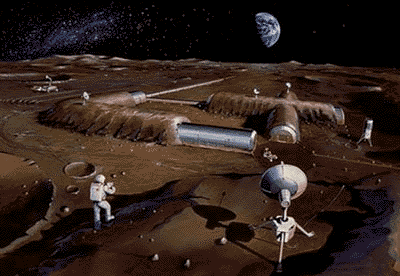Energy consumption on Earth is expected to increase at a very rapid rate in the coming decades. One scientist offers an unusual solution to the impending crisis: a power plant on the moon

Future base on the moon. Artist illustration, NASA
Direct link to this page: https://www.hayadan.org.il/moonpower010102.html
Energy consumption on Earth is expected to increase at a very rapid rate in the coming decades. One scientist offers an unusual solution to the impending crisis: a power plant on the moon.
Prof. David Criswell (David Criswell) from the Space Research Institute at the University of Houston, says that the lunar power plant will capture the sun's rays and launch them to Earth in a concentrated microwave beam. With this method, it will be possible to produce cheap, clean and stable electricity for the growing population of the earth. "This is energy on a global scale," Criswell said at the American Geophysical Union (AGU) meeting. Criswell's idea may seem fictional, but he insists and says that it is within the reach of the US government, three times the cost of the Apollo operation, about 60 billion dollars.
Intermediate: A giant microwave oven
Criswell's power plant idea is just one of the alternative energy ideas raised at the conference, which centered on the question of how to deal with the growing energy consumption on Earth. Today, 85 percent of energy is produced by burning fossil fuels, which create greenhouse gases, and many scientists claim that they are also the main cause of global warming. Now, the researchers say, we must finance new methods to produce energy, if economic growth is to continue without destroying the environment. According to Criswell, the moon is the most obvious choice for the establishment of power facilities that would not involve the danger of nuclear contamination in the power plants on Earth. Criswell's plan involves setting up solar power plants in huge farms at several points on the surface of the moon, to collect the sun's rays. This energy will be converted into a microwave beam that will be sent to suitable receivers on Earth, where they can turn it back into electricity and transfer it to the electricity grid.
The microwave beam, which can also penetrate through clouds and rain, will have an intensity of about twenty percent of the sunlight at noon, and will therefore be safe. It will cause only minor interference to local radio systems, Criswell says, adding that the station could be built from materials that are abundant on the lunar soil. The materials are quite simple from a technological point of view, so the station can be set up quickly. "This is the same technology found in home microwave devices," he says.
He is aware that some people may be concerned if the systems fall into hostile hands, which could turn these beams into some kind of weapon capable of destroying the Earth from space: "Almost anything can be turned into a weapon." He adds and says that he is sure that strict protection regulations will be part of the system to prevent the fund from becoming a death fund. Criswell estimates that building a prototype of the station will cost $9 billion. After it is proven that it works, it will be possible to add another 50 billion dollars to build a complete system, which will return the investment on it within five years. "It's an economically viable proposition," he concludes.
The idea of extraterrestrial power plants is not new. Satellites capable of generating electricity have been tested since the 60s of the 20th century and from time to time the idea of building them pops up, but falls mainly from the economic point of view. According to Criswell, the idea of establishing the station on the moon makes more sense.
"Why build a satellite? We already have one of these," he says.
